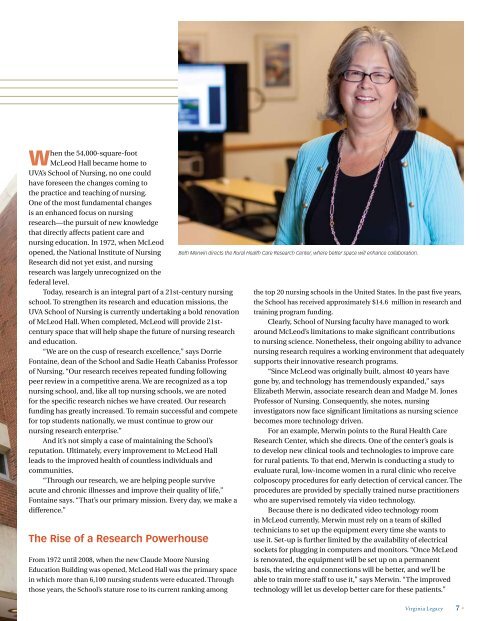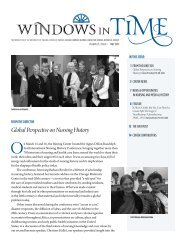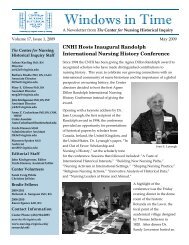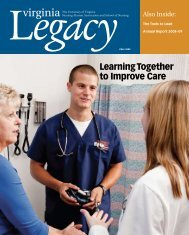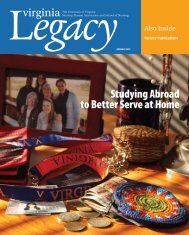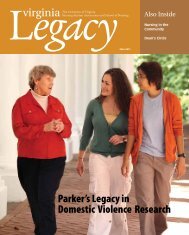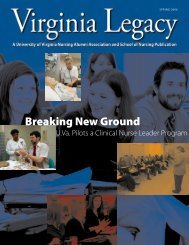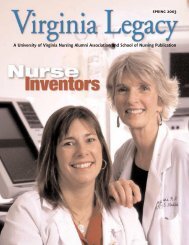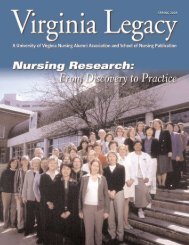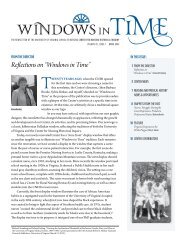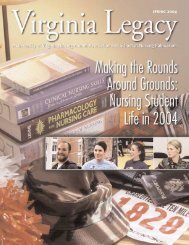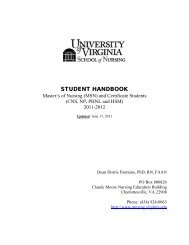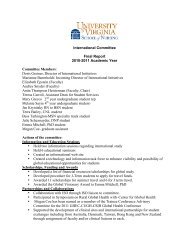Transforming McLeod Hall - School of Nursing - University of Virginia
Transforming McLeod Hall - School of Nursing - University of Virginia
Transforming McLeod Hall - School of Nursing - University of Virginia
You also want an ePaper? Increase the reach of your titles
YUMPU automatically turns print PDFs into web optimized ePapers that Google loves.
When the 54,000-square-foot<br />
<strong>McLeod</strong> <strong>Hall</strong> became home to<br />
UVA’s <strong>School</strong> <strong>of</strong> <strong>Nursing</strong>, no one could<br />
have foreseen the changes coming to<br />
the practice and teaching <strong>of</strong> nursing.<br />
One <strong>of</strong> the most fundamental changes<br />
is an enhanced focus on nursing<br />
research—the pursuit <strong>of</strong> new knowledge<br />
that directly affects patient care and<br />
nursing education. In 1972, when <strong>McLeod</strong><br />
opened, the National Institute <strong>of</strong> <strong>Nursing</strong><br />
Research did not yet exist, and nursing<br />
research was largely unrecognized on the<br />
federal level.<br />
Today, research is an integral part <strong>of</strong> a 21st-century nursing<br />
school. To strengthen its research and education missions, the<br />
UVA <strong>School</strong> <strong>of</strong> <strong>Nursing</strong> is currently undertaking a bold renovation<br />
<strong>of</strong> <strong>McLeod</strong> <strong>Hall</strong>. When completed, <strong>McLeod</strong> will provide 21stcentury<br />
space that will help shape the future <strong>of</strong> nursing research<br />
and education.<br />
“We are on the cusp <strong>of</strong> research excellence,” says Dorrie<br />
Fontaine, dean <strong>of</strong> the <strong>School</strong> and Sadie Heath Cabaniss Pr<strong>of</strong>essor<br />
<strong>of</strong> <strong>Nursing</strong>. “Our research receives repeated funding following<br />
peer review in a competitive arena. We are recognized as a top<br />
nursing school, and, like all top nursing schools, we are noted<br />
for the specific research niches we have created. Our research<br />
funding has greatly increased. To remain successful and compete<br />
for top students nationally, we must continue to grow our<br />
nursing research enterprise.”<br />
And it’s not simply a case <strong>of</strong> maintaining the <strong>School</strong>’s<br />
reputation. Ultimately, every improvement to <strong>McLeod</strong> <strong>Hall</strong><br />
leads to the improved health <strong>of</strong> countless individuals and<br />
communities.<br />
“Through our research, we are helping people survive<br />
acute and chronic illnesses and improve their quality <strong>of</strong> life,”<br />
Fontaine says. “That’s our primary mission. Every day, we make a<br />
difference.”<br />
The Rise <strong>of</strong> a Research Powerhouse<br />
From 1972 until 2008, when the new Claude Moore <strong>Nursing</strong><br />
Education Building was opened, <strong>McLeod</strong> <strong>Hall</strong> was the primary space<br />
in which more than 6,100 nursing students were educated. Through<br />
those years, the <strong>School</strong>’s stature rose to its current ranking among<br />
Beth Merwin directs the Rural Health Care Research Center, where better space will enhance collaboration.<br />
the top 20 nursing schools in the United States. In the past five years,<br />
the <strong>School</strong> has received approximately $14.6 million in research and<br />
training program funding.<br />
Clearly, <strong>School</strong> <strong>of</strong> <strong>Nursing</strong> faculty have managed to work<br />
around <strong>McLeod</strong>’s limitations to make significant contributions<br />
to nursing science. Nonetheless, their ongoing ability to advance<br />
nursing research requires a working environment that adequately<br />
supports their innovative research programs.<br />
“Since <strong>McLeod</strong> was originally built, almost 40 years have<br />
gone by, and technology has tremendously expanded,” says<br />
Elizabeth Merwin, associate research dean and Madge M. Jones<br />
Pr<strong>of</strong>essor <strong>of</strong> <strong>Nursing</strong>. Consequently, she notes, nursing<br />
investigators now face significant limitations as nursing science<br />
becomes more technology driven.<br />
For an example, Merwin points to the Rural Health Care<br />
Research Center, which she directs. One <strong>of</strong> the center’s goals is<br />
to develop new clinical tools and technologies to improve care<br />
for rural patients. To that end, Merwin is conducting a study to<br />
evaluate rural, low-income women in a rural clinic who receive<br />
colposcopy procedures for early detection <strong>of</strong> cervical cancer. The<br />
procedures are provided by specially trained nurse practitioners<br />
who are supervised remotely via video technology.<br />
Because there is no dedicated video technology room<br />
in <strong>McLeod</strong> currently, Merwin must rely on a team <strong>of</strong> skilled<br />
technicians to set up the equipment every time she wants to<br />
use it. Set-up is further limited by the availability <strong>of</strong> electrical<br />
sockets for plugging in computers and monitors. “Once <strong>McLeod</strong><br />
is renovated, the equipment will be set up on a permanent<br />
basis, the wiring and connections will be better, and we’ll be<br />
able to train more staff to use it,” says Merwin. “The improved<br />
technology will let us develop better care for these patients.”<br />
<strong>Virginia</strong> Legacy 7 •


